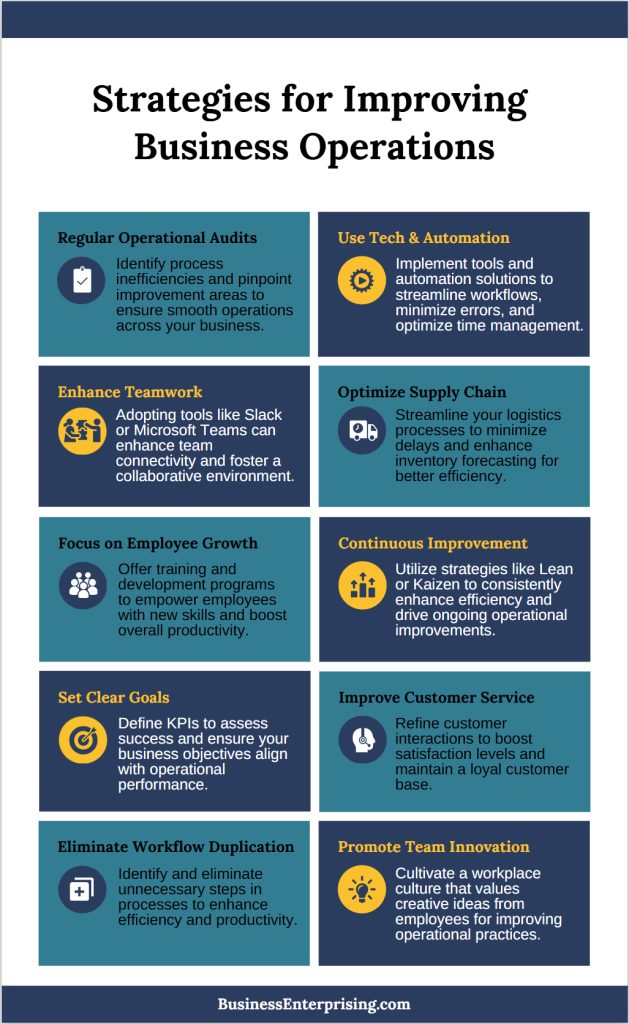
Understanding how to improve business operations involves exploring multiple strategies. For example, you might focus on leveraging technology, enhancing communication, or investing in employee development. Additionally, fostering a culture of continuous improvement ensures your business adapts to new challenges and opportunities. When your team works cohesively toward shared goals, better outcomes follow.
Every business has opportunities to refine its operations. Whether you want to cut unnecessary steps or improve team collaboration, taking actionable steps matters. By making consistent improvements, you position your business for long-term growth and efficiency.
Conducting an Operational Audit
Conducting an operational audit is an effective way to identify inefficiencies and discover how to improve business operations. Assessing your current processes allows you to understand what works and what doesn’t. This insight can lead to streamlined workflows, reduced costs, and higher productivity. Without regularly evaluating operations, inefficiencies may remain hidden and hinder growth.
To identify inefficiencies, you can use tools like workflow mapping, performance metrics, and data analytics software. These tools help visualize your processes and pinpoint bottlenecks. Additionally, employee feedback and customer reviews often reveal issues that might otherwise be missed. Combining qualitative insights with quantitative data offers a comprehensive view of your operations.
It’s also important to involve your team in the audit process. Their firsthand knowledge provides context and practical solutions. Regular team meetings or structured surveys can encourage open communication and collaborative problem-solving. When employees contribute to identifying challenges, they are more likely to support changes that improve efficiency.
By focusing on regular evaluations and fostering collaboration, you can create a framework for better operations. With actionable insights and team involvement, you’ll be well on your way to refining how your business runs.
Leveraging Technology and Automation
Leveraging technology and automation is a practical way to improve efficiency and discover how to improve business operations. Many tools and software options are designed to streamline repetitive tasks, saving time and reducing errors. For example, project management platforms like Asana or Trello help organize workflows, while customer relationship management tools like Salesforce simplify client interactions.
Automation offers many benefits, especially for repetitive tasks that consume significant time. For instance, automating data entry or invoicing allows your team to focus on higher-value work. Additionally, automated tools can reduce human error, providing more consistent and reliable results. By removing manual tasks, you can allocate resources more effectively and improve overall productivity.
Consider businesses that adopted automation and saw measurable improvements. A logistics company, for instance, might use route optimization software to shorten delivery times and cut fuel costs. Similarly, an e-commerce store could implement chatbots to handle customer inquiries, freeing up support staff for complex issues. These examples demonstrate how adopting technology can drive efficiency and support growth.
By adopting the right tools and automating routine processes, you can create a smoother workflow. This approach not only saves time but also enhances your ability to scale operations effectively. Transitioning to tech-driven solutions is a proven step toward building a more efficient business.
Streamlining Communication and Collaboration
Effective communication is a cornerstone of operational success. When communication is clear and timely, teams can collaborate more efficiently and make better decisions. Miscommunication, on the other hand, can lead to missed deadlines, errors, and frustration. Therefore, improving communication should be a priority if you want to discover how to improve business operations.
Collaboration tools like Slack and Microsoft Teams can help centralize communication and streamline workflows. These platforms enable instant messaging, file sharing, and video calls, keeping everyone connected. Additionally, they integrate with other tools, making it easier to manage projects and track progress. By adopting these solutions, you can eliminate email overload and improve response times.
Fostering a culture of transparency further supports effective communication. Encouraging open dialogue and sharing updates regularly helps build trust among team members. For example, holding brief daily check-ins or weekly updates keeps everyone informed and aligned. Additionally, addressing concerns promptly shows employees that their input is valued and respected.
Improved communication and collaboration lead to better coordination and stronger teamwork. By using the right tools and creating an open environment, you set the foundation for smoother operations. These efforts will not only strengthen your team’s cohesion but also contribute to your broader business goals.
Optimizing Supply Chain and Inventory Management
Optimizing your supply chain and inventory management is an effective way to discover how to improve business operations. Efficient supply chains rely on streamlined processes and reliable partnerships. Therefore, it’s important to identify delays or bottlenecks and work with vendors to improve delivery times. Additionally, investing in technology like logistics software can provide real-time tracking and enhance decision-making.
Accurate inventory forecasting plays a significant role in reducing waste and avoiding stockouts. Using demand planning tools, you can analyze historical data and predict future trends. Additionally, setting clear reorder points and regularly updating your forecasts helps maintain balance. When you align your inventory levels with demand, you save resources and keep customers satisfied.
Reducing costs while maintaining quality requires a strategic approach. For example, you might consolidate shipments to lower transportation expenses. Another option is to negotiate better terms with suppliers without sacrificing product standards. Furthermore, regular quality checks prevent issues that can result in expensive returns or lost sales.
Focusing on supply chain efficiency and inventory management creates lasting benefits for your business. With thoughtful planning and the right tools, you can enhance productivity, reduce expenses, and maintain customer satisfaction. These improvements not only strengthen operations but also position you for sustained success.
Implementing Continuous Improvement Strategies
Implementing continuous improvement strategies helps you discover how to improve business operations and build a more efficient organization. Methodologies like Lean, Six Sigma, and Kaizen offer proven frameworks for identifying inefficiencies and driving change. Lean focuses on eliminating waste, while Six Sigma emphasizes reducing errors through data-driven approaches. Additionally, Kaizen encourages small, consistent changes that lead to long-term results.
Encouraging innovation and adaptability within your team is essential for continuous improvement. Regular brainstorming sessions can help generate fresh ideas and solutions. Furthermore, creating an environment where employees feel safe sharing suggestions fosters collaboration and engagement. When your team is actively involved, they become more invested in the success of your initiatives.
Tracking progress and celebrating milestones keeps your team motivated and focused. Regularly measure key performance indicators to evaluate the effectiveness of new strategies. Additionally, acknowledging achievements—both big and small—reinforces a sense of accomplishment. Celebrations also provide an opportunity to reflect on successes and refine future plans.
Continuous improvement is an ongoing process that strengthens your business over time. By embracing proven methodologies, fostering innovation, and recognizing progress, you create a culture of growth. This approach not only enhances efficiency but also builds a foundation for sustainable success.
Investing in Employee Development and Training
Investing in employee development and training is a practical way to discover how to improve business operations. Skilled employees perform tasks more efficiently and deliver consistent results. Additionally, training enhances their confidence, which improves overall team morale and collaboration. When your workforce is knowledgeable and adaptable, operations run more smoothly, and challenges are addressed faster.
Creating effective training programs begins with identifying specific skill gaps in your team. Tailored programs that combine hands-on activities and clear learning objectives often produce the best results. Additionally, offering ongoing opportunities such as workshops or online courses keeps employees engaged and updated. Encouraging feedback after each session also helps refine future training efforts, making them even more impactful.
Leadership development plays a key role in operational excellence. Well-trained leaders set clear expectations, motivate their teams, and make sound decisions under pressure. Furthermore, effective leaders create a positive work environment where employees feel supported. By fostering strong leadership, you create a ripple effect that enhances efficiency throughout the organization.
Employee development is an investment that pays dividends in improved performance and smoother workflows. By equipping your team with the right skills and nurturing strong leaders, you can build a resilient and effective workforce. This focus on growth not only benefits individuals but also strengthens the foundation of your business.
Conclusion
Improving business operations requires a strategic focus on key areas like efficiency, communication, and employee development. By adopting practical strategies, you can create lasting improvements that benefit your team and your bottom line. Additionally, leveraging technology and fostering continuous improvement ensures your processes remain adaptable in a changing environment. When you prioritize these efforts, you build a stronger foundation for growth.
However, success depends on consistent action and collaboration across your organization. Regularly assess progress, involve your team, and make adjustments as needed. By working together and maintaining clear goals, you can continue to refine how to improve business operations effectively. These steps not only enhance productivity but also position your business for sustained success.



